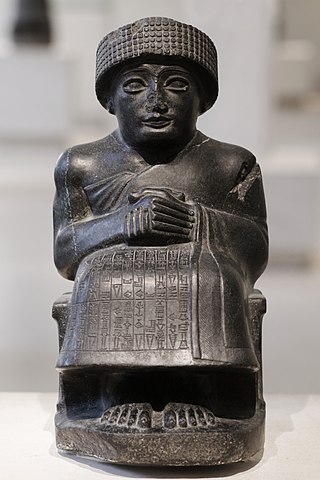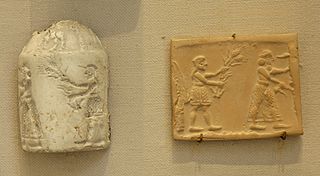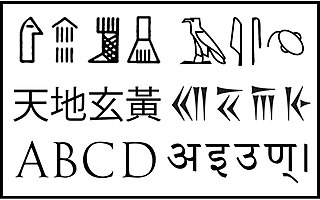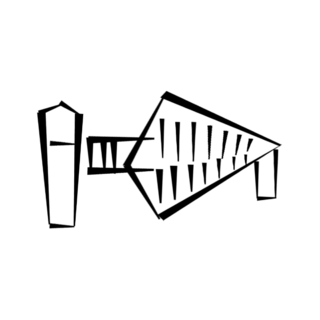Related Research Articles

Papyrus is a material similar to thick paper that was used in ancient times as a writing surface. It was made from the pith of the papyrus plant, Cyperus papyrus, a wetland sedge. Papyrus can also refer to a document written on sheets of such material, joined side by side and rolled up into a scroll, an early form of a book.

Sumer is the earliest known civilization, located in the historical region of southern Mesopotamia, emerging during the Chalcolithic and early Bronze Ages between the sixth and fifth millennium BC. Like nearby Elam, it is one of the cradles of civilization, along with Egypt, the Indus Valley, the Erligang culture of the Yellow River valley, Caral-Supe, and Mesoamerica. Living along the valleys of the Tigris and Euphrates rivers, Sumerian farmers grew an abundance of grain and other crops, a surplus which enabled them to form urban settlements. The world's earliest known texts come from the Sumerian cities of Uruk and Jemdet Nasr, and date to between c. 3350 – c. 2500 BC, following a period of proto-writing c. 4000 – c. 2500 BC.

The Sumerian King List or Chronicle of the One Monarchy is an ancient literary composition written in Sumerian that was likely created and redacted to legitimize the claims to power of various city-states and kingdoms in southern Mesopotamia during the late third and early second millennium BC. It does so by repetitively listing Sumerian cities, the kings that ruled there, and the lengths of their reigns. Especially in the early part of the list, these reigns often span thousands of years. In the oldest known version, dated to the Ur III period but probably based on Akkadian source material, the SKL reflected a more linear transition of power from Kish, the first city to receive kingship, to Akkad. In later versions from the Old Babylonian period, the list consisted of a large number of cities between which kingship was transferred, reflecting a more cyclical view of how kingship came to a city, only to be inevitably replaced by the next. In its best-known and best-preserved version, as recorded on the Weld-Blundell Prism, the SKL begins with a number of antediluvian kings, who ruled before a flood swept over the land, after which kingship went to Kish. It ends with a dynasty from Isin, which is well-known from other contemporary sources.

The history of Sumer spans the 5th to 3rd millennia BCE in southern Mesopotamia, and is taken to include the prehistoric Ubaid and Uruk periods. Sumer was the region's earliest known civilization and ended with the downfall of the Third Dynasty of Ur around 2004 BCE. It was followed by a transitional period of Amorite states before the rise of Babylonia in the 18th century BCE.
Uruk, today known as Warka, was a city in the ancient Near East situated east of the present bed of the Euphrates River on the dried-up ancient channel of the Euphrates. The site lies 93 kilometers northwest of ancient Ur, 108 kilometers southeast of ancient Nippur, and 24 kilometers southeast of ancient Larsa. It is 30 km (19 mi) east of modern Samawah, Al-Muthannā, Iraq.

In the Ancient Near East, clay tablets were used as a writing medium, especially for writing in cuneiform, throughout the Bronze Age and well into the Iron Age.

Cuneiform is a logo-syllabic writing system that was used to write several languages of the Ancient Near East. The script was in active use from the early Bronze Age until the beginning of the Common Era. Cuneiform scripts are marked by and named for the characteristic wedge-shaped impressions which form their signs. Cuneiform is the earliest known writing system and was originally developed to write the Sumerian language of southern Mesopotamia.

Adab or Udab was an ancient Sumerian city between Girsu and Nippur. It was located at the site of modern Bismaya or Bismya in the Wasit Province of Iraq. The city-god of Adab was Parag'ellilegarra (Panigingarra) "The Sovereign Appointed by Ellil".

Music was ubiquitous throughout Mesopotamian history, playing important roles in both religious and secular contexts. Mesopotamia is of particular interest to scholars because evidence from the region—which includes artifacts, artistic depictions, and written records—places it among the earliest well-documented cultures in the history of music. The discovery of a bone wind instrument dating to the 5th millennium BCE provides the earliest evidence of music culture in Mesopotamia; depictions of music and musicians appear in the 4th millennium BCE; and later, in the city of Uruk, the pictograms for ‘harp’ and ‘musician’ are present among the earliest known examples of writing.

Used by Sumerians and other Mesopotamian cultures beginning in the third millennium BC, clay nails, also referred to as dedication or foundation pegs, cones, or nails, were cone-shaped nails made of clay, inscribed with cuneiform, baked, and stuck into the mudbrick walls to serve as evidence that the temple or building was the divine property of the god to whom it was dedicated. Versions were also made of metal, including castings with figurative designs, such as the Hurrian foundation pegs.

A cylinder seal is a small round cylinder, typically about one inch in length, engraved with written characters or figurative scenes or both, used in ancient times to roll an impression onto a two-dimensional surface, generally wet clay. According to some sources, cylinder seals were invented around 3500 BC in the Near East, at the contemporary sites of Uruk in southern Mesopotamia and slightly later at Susa in south-western Iran during the Proto-Elamite period, and they follow the development of stamp seals in the Halaf culture or slightly earlier. They are linked to the invention of the latter's cuneiform writing on clay tablets. Other sources, however, date the earliest cylinder seals to a much earlier time, to the Late Neolithic period in Syria, hundreds of years before the invention of writing.

The history of writing traces the development of writing systems and how their use transformed and was transformed by different societies. The use of writing prefigures various social and psychological consequences associated with literacy and literary culture.
Khafajah or Khafaje, ancient Tutub, is an archaeological site in Diyala Governorate, Iraq 7 miles (11 km) east of Baghdad. Khafajah lies on the Diyala River, a tributary of the Tigris. Occupied from the Uruk and Jemdet Nasr periods through the end of the Old Babylonian Empire, it was under the control of the Akkadian Empire and then the Third Dynasty of Ur in the 3rd millennium BC. It then became part of the empire of the city-state of Eshnunna lying 12 miles (19 km) southwest of that city, about 5 miles (8.0 km) from the ancient city of Shaduppum, and near Tell Ishchali, both which Eshnunna also controlled. It then fell to Babylonia before falling into disuse.

The art of Mesopotamia has survived in the record from early hunter-gatherer societies on to the Bronze Age cultures of the Sumerian, Akkadian, Babylonian and Assyrian empires. These empires were later replaced in the Iron Age by the Neo-Assyrian and Neo-Babylonian empires. Widely considered to be the cradle of civilization, Mesopotamia brought significant cultural developments, including the oldest examples of writing.
Wayne Horowitz is an archeologist and academic. He specialises in the ancient Near East and Assyriology.

Sîn-kāšid was the king of the ancient Mesopotamian city of Uruk during the first half of the 18th century BC. His precise dating is uncertain, perhaps ca. 1803–1770 BC corresponding to ca.1865–1833 BC, but likely to have been fairly long due to the voluminous building inscriptions extant for which he is best known and contemporary with Nur-Adad of Larsa and Enlil-bāni of Isin. His apparent lack of relationship with any of the preceding rulers of Uruk and his omission of mentioning his father in any of his inscriptions has led to the belief that he was the founder of a dynasty. He participated in a diplomatic marriage with Šallurtum, the daughter of Sūmû-la-Il, the second king of the First Babylonian Dynasty, as her name and epithets appear in the seal impressions of three clay bullae recovered from the remains of his palace.

Kushim is supposedly the earliest known recorded name of a person in writing. The name "Kushim" is found on several Uruk period clay tablets used to record transactions of barley. It is uncertain if the name refers to an individual, a generic title of an officeholder, or an institution.

The Ugaritic texts are a corpus of ancient cuneiform texts discovered since 1928 in Ugarit and Ras Ibn Hani in Syria, and written in Ugaritic, an otherwise unknown Northwest Semitic language. Approximately 1,500 texts and fragments have been found to date. The texts were written in the 13th and 12th centuries BC.

Egypt–Mesopotamia relations were the relations between the civilizations of ancient Egypt and Mesopotamia, in the Middle East. They seem to have developed from the 4th millennium BCE, starting in the Uruk period for Mesopotamia and the half a millennium younger Gerzean culture of Prehistoric Egypt, and constituted a largely one way body of influences from Mesopotamia into Egypt.
An = Anum, also known as the Great God List, is the longest preserved Mesopotamian god list, a type of lexical list cataloging the deities worshiped in the Ancient Near East, chiefly in modern Iraq. While god lists are already known from the Early Dynastic period, An = Anum most likely was composed in the later Kassite period.
References
- ↑ Hayes, John L., 1990 A Manual of Sumerian Grammar and Texts, Undena Publications, p.266
- ↑ Krulwich, Robert (2015-08-19). "Who's the First Person in History Whose Name We Know?". National Geographic . Archived from the original on July 7, 2018.
- ↑ "Oldest love poem". Guinness World Records. Retrieved 2019-09-06.
- ↑ Fant, Clyde E.; Reddish, Mitchell G. (2008-10-15). Lost Treasures of the Bible: Understanding the Bible Through Archaeological Artifacts in World Museums. Wm. B. Eerdmans Publishing. ISBN 9780802828811.[ verification needed ]
- ↑ Sebnem Arsu. The Oldest Line in the World // The New York Times, 14-Feb-2006. [ verification needed ]
- ↑ "Mesopotamian Ingredients".
- ↑ "Letters - Archaeology Magazine". www.archaeology.org. Retrieved 2019-09-05.
- ↑ "Oldest written document ever found in Jerusalem discovered". ScienceDaily. Retrieved 2019-09-05.
- ↑ "Oldest Known Document Uncovered in Jerusalem". Voice of America. Retrieved 2019-09-05.
- ↑ "Tiny fragment bears oldest script found in Jerusalem". The Daily Telegraph. 2010-07-12. ISSN 0307-1235 . Retrieved 2019-09-05.
- ↑ Qiu, Xigui, 2000 Chinese writing, trans. by Gilbert L. Mattos and Jerry Norman, Berkeley: Society for the Study of Early China and The Institute of East Asian Studies, University of California, ISBN 978-1-55729-071-7. (English translation of Wénzìxué Gàiyào 文字學概要, Shangwu, 1988.)
- ↑ Davies, Philip R. "Dead Sea Scrolls". britannica.com. Encyclopaedia Britannica. Retrieved 14 January 2024.
- ↑ "Scotland's oldest surviving book still in Scotland: The Celtic Psalter | Transceltic - Home of the Celtic nations". www.transceltic.com. 14 July 2017. Retrieved 2019-09-05.
- ↑ "Search Results: All Fields similar to 'Celtic and Psalter' and What equal to 'Celtic Psalter, 11th C.' - University of Edinburgh". images.is.ed.ac.uk. Retrieved 2019-09-05.